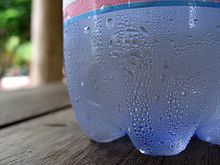Condensation
It has been suggested that Condensation (aerosol dynamics) be merged into this article. (Discuss) Proposed since June 2009. |



Condensation is the change of the physical state of matter from gaseous phase into liquid phase, and is the reverse of evaporation.[1] When the transition happens from the gaseous phase into the solid phase directly, the change is called deposition.
Upon the slowing-down of the molecules of the material, the overall attraction forces between these prevail and bring them together at distances comparable to their sizes. Since the condensing molecules suffer from reduced degrees of freedom and ranges of motion, their prior kinetic energy must be transferred to an absorbing colder entity—either a center of condensation within the gas volume (colder molecules of the species, cold grains of dust etc.) or some contact surface. Condensation is initiated by the formation of atomic/molecular clusters of that species within its gaseous volume—like rain drop or snow-flake formation within clouds—or at the contact between such gaseous phase and a (solvent) liquid or solid surface.
A few distinct reversibility scenarios emerge here with respect to the nature of the surface.
- absorption into the surface of a liquid (either of the same species or one of its solvents)—is reversible as evaporation.[2].
- adsorption (as dew droplets) onto solid surface at pressures and temperatures higher than the specie's triple point—also reversible as evaporation.
- adsorption onto solid surface (as supplemental layers of solid) at pressures and temperatures lower than the specie's triple point—is reversible as sublimation.
Condensation commonly occurs when a vapor is cooled and/or compressed to its saturation limit when the molecular density in the gas phase reaches its maximal threshold. Vapor cooling and compressing equipment that collects condensed liquids is called "condenser".
Psychrometry measures the rates of condensation from and evaporation into the air moisture at various atmospheric pressures and temperatures. Water is the product of its vapor condensation—condensation is the process of such phase conversion.
Applications of condensation
Condensation is a crucial component of distillation, an important laboratory and industrial chemistry application.
Because condensation is a naturally occurring phenomenon, it can often be used to generate water in large quantities for human use. Many structures are made solely for the purpose of collecting water from condensation, such as air wells and fog fences. Such systems can often be used to retain soil moisture in areas where active desertification is occurring—so much so that some organizations educate people living in affected areas about water condensers to help them deal effectively with the situation.[3]
It is also a crucial process in forming particle tracks in a Cloud Chamber. In this case, ions produced by an incident particle act as nucleation centres for the vapour to condense on.
Biological adaptation
Numerous living organisms use water made accessible by condensation. A few examples are the Australian Thorny Devil, Darkling beetles on the Namibian coast and Coast Redwoods on the west coast of the United States.
See also
- Air well (condenser)
- Kelvin equation
- Retrograde condensation
- Phase diagram
- Phase transition
- Condenser (heat transfer)
- Surface condenser
- Bose–Einstein condensate
- DNA condensation
Notes
- ^ IUPAC, Compendium of Chemical Terminology, 2nd ed. (the "Gold Book") (1997). Online corrected version: (2006–) "condensation in atmospheric chemistry". doi:10.1351/goldbook.C01235
- ^ IUPAC, Compendium of Chemical Terminology, 2nd ed. (the "Gold Book") (1997). Online corrected version: (2006–) "condensation in atmospheric chemistry". doi:10.1351/goldbook.C01235
- ^ FogQuest - Fog Collection / Water Harvesting Projects - Welcome
